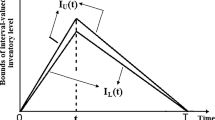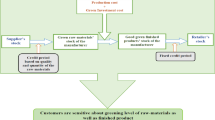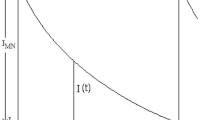Abstract
The use of chemicals and preservatives during the production of most daily-used products has increased rapidly over the last few decades. In turn, manufacturers, to improve the sustainability of a manufacturing unit in the current highly competitive market, are obliged to provide various facilities to their customers. However, estimating the best optimal decision for manufacturing companies seems like a daunting task amid highly uncertain market conditions. By shedding more light on these facts and considering the gaps in the existing literature on production inventory, this work aims to incorporate a production model which is concerned with the factors mentioned above, so that it can be beneficial for a manufacturer. This work involves the demonstration of an imperfect green production system under single-layer full-trade credit financing and partial backlog shortages using interval flexibility. Based on the credit period lengths provided by the manufacturer to the consumers, three distinct cases have arisen and for each case, the average profit of the system appears to be an interval valued optimal control problem, and several theorems are evaluated to obtain analytical forms of respective objective functions of each case. Additionally, to test the effect of different credit lengths on optimal policy and to examine the feasibility of each case, a numerical example is solved using the Equilibrium Optimizer (EO) algorithm. Finally, a sensitivity experiment is performed and the results obtained from the simulation are shown graphically to gain some managerial insights.






Similar content being viewed by others
Data Availability
There is no data available.
References
Luh YP, Chu CH, Pan CC (2010) Data management of green product development with generic modularized product architecture. Comput Ind 61(3):223–234
Lin RJ, Tan KH, Geng Y (2013) Market demand, green product innovation, and firm performance: evidence from Vietnam motorcycle industry. J Clean Prod 40:101–107
Zhang CT, Wang HX, Ren ML (2014) Research on pricing and coordination strategy of green supply chain under hybrid production mode. Comput Ind Eng 72:24–31
Entezaminia A, Heydari M, Rahmani D (2016) A multi-objective model for multi-product multi-site aggregate production planning in a green supply chain: Considering collection and recycling centers. J Manuf Syst 40:63–75
Bai C, Shah P, Zhu Q, Sarkis J (2018) Green product deletion decisions: An integrated sustainable production and consumption approach. Ind Manag Data Syst 118(2):349–389
Saxena S, Gupta RK, Singh V, Singh P, Mishra NK (2018) Environmental Sustainability with eco-friendly green inventory model under Fuzzy logics considering carbon emission. JETIR 5(11):1–12
Yavari M, Geraeli M (2019) Heuristic method for robust optimization model for green closed-loop supply chain network design of perishable goods. J Clean Prod 226:282–305
Sana SS (2020) Price competition between green and non green products under corporate social responsible firm. J Retail Consum Serv 55:102118
Sarkar B, Ullah M, Sarkar M (2021) Environmental and economic sustainability through innovative green products by remanufacturing. J Clean Prod 2021:129813
Ghosh PK, Manna AK, Dey JK, Kar S (2021) Supply chain coordination model for green product with different payment strategies: A game theoretic approach. J Clean Prod 290:125734
Kundu A, Guchhait P, Maiti M, Castillo O (2021) Inventory of a deteriorating green product with preservation technology cost using a hybrid algorithm. Soft Comput 25(17):11621–11636
Paul A, Pervin M, Roy SK, Maculan N, Weber GW (2022) A green inventory model with the effect of carbon taxation. Ann Oper Res 309(1):233–248
Jauhari WA, Wangsa ID (2022) A Manufacturer-Retailer Inventory Model with Remanufacturing, Stochastic Demand, and Green Investments. Process Integr Optim Sustain:1–21
Rosenblatt MJ, Lee HL (1986) Economic production cycles with imperfect production processes. IIE Trans 18(1):48–55
Salameh MK, Jaber MY (2000) Economic production quantity model for items with imperfect quality. Int J Prod Econ 64(1-3):59–64
Chiu SW, Gong DC (2004) Determining the optimal lot size for the finite production model with an imperfect rework process of defective items. J Inf Optim Sci 25(1):105–119
Goyal SK, Cárdenas-Barrón LE (2005) Economic production quantity with imperfect production system. Ind Eng J 34(2):33–36
Sana SS, Goyal SK, Chaudhuri K (2007) An imperfect production process in a volume flexible inventory model. Int J Prod Econ 105(2):548–559
Bhunia AK, Shaikh AA, Cárdenas-Barrón LE (2017) A partially integrated production-inventory model with interval valued inventory costs, variable demand and flexible reliability. Appl Soft Comput 55:491–502
Shah NH, Patel DG, Shah DB (2018) EPQ model for returned/reworked inventories during imperfect production process under price-sensitive stock-dependent demand. Oper Res 18(2):343–359
Vercraene S, Gayon JP (2013) Optimal control of a production-inventory system with product returns. Int J Prod Econ 142(2):302–310
Khatua D, Maity K, Kar S (2019) A Fuzzy Optimal Control Inventory Model of Product–Process Innovation and Fuzzy Learning Effect in Finite Time Horizon. Int J Fuzzy Syst 21(5):1560–1570
Das B, Maiti M (2013) Fuzzy stochastic inequality and equality possibility constraints and their application in a production-inventory model via optimal control method. J Comput Sci 4(5):360–369
Maity K, Maiti M (2007) Possibility and necessity constraints and their defuzzification—a multi-item production-inventory scenario via optimal control theory. Eur J Oper Res 177(2):882–896
Das S, Mondal R, Shaikh AA, Bhunia AK (2022) An application of control theory for imperfect production problem with carbon emission investment policy in interval environment. J Frankl Inst 359(5):1925–1970
Goyal SK (1985) Economic order quantity under conditions of permissible delay in payments. J Oper Res Soc:335–338
Petersen MA, Rajan RG (1997) Trade credit: theories and evidence. Rev Financ Stud 10(3):661–691
Ge Y, Qiu J (2007) Financial development, bank discrimination and trade credit. J Bank Financ 31(2):513–530
Teng JT, Chang CT (2009) Optimal manufacturer’s replenishment policies in the EPQ model under two levels of trade credit policy. Eur J Oper Res 195(2):358–363
Chen SC, Cárdenas-Barrón LE, Teng JT (2014) Retailer’s economic order quantity when the supplier offers conditionally permissible delay in payments link to order quantity. Int J Prod Econ 155:284–291
Sundara Rajan R, Uthayakumar R (2017) Analysis and optimization of an EOQ inventory model with promotional efforts and back ordering under delay in payments. J Manag Anal 4(2):159–181
Wu J, Chang CT, Teng JT, Lai KK (2017) Optimal order quantity and selling price over a product life cycle with deterioration rate linked to expiration date. Int J Prod Econ 193:343–351
Ouyang LY, Chang CT (2013) Optimal production lot with imperfect production process under permissible delay in payments and complete backlogging. Int J Prod Econ 144(2):610–617
Tiwari S, Cárdenas-Barrón LE, Goh M, Shaikh AA (2018) Joint pricing and inventory model for deteriorating items with expiration dates and partial backlogging under two-level partial trade credits in supply chain. Int J Prod Econ 200:16–36
Mishra U, Wu JZ, Tseng ML (2019) Effects of a hybrid-price-stock dependent demand on the optimal solutions of a deteriorating inventory system and trade credit policy on re-manufactured product. J Clean Prod 241:118282
Shaikh AA, Cardenas-Barron LE, Manna AK, Cespedes-Mota A (2020) An economic production quantity (EPQ) model for a deteriorating item with partial trade credit policy for price dependent demand under inflation and reliability. Yugoslav J Oper Res 31(2)):139–151
Ghosh PK, Manna AK, Dey JK, Kar S (2021) An EOQ model with backordering for perishable items under multiple advanced and delayed payments policies. J Manag Anal:1–32
Bi G, Wang P, Wang D, Yin Y (2021) Optimal credit period and ordering policy with credit-dependent demand under two-level trade credit. Int J Prod Econ 242:108311
Chang HJ, Dye CY (2001) An inventory model for deteriorating items with partial backlogging and permissible delay in payments. Int J Syst Sci 32(3):345–352
Papachristos S, Skouri K (2003) An inventory model with deteriorating items, quantity discount, pricing and time-dependent partial backlogging. Int J Prod Econ 83(3):247–256
Rong M, Mahapatra NK, Maiti M (2008) A two warehouse inventory model for a deteriorating item with partially/fully backlogged shortage and fuzzy lead time. Eur J Oper Res 189(1):59–75
Yang HL, Teng JT, Chern MS (2010) An inventory model under inflation for deteriorating items with stock-dependent consumption rate and partial backlogging shortages. Int J Prod Econ 123(1):8–19
Bhunia AK, Shaikh AA, Sharma G, Pareek S (2015) A two storage inventory model for deteriorating items with variable demand and partial backlogging. J Ind Prod Eng 32(4):263–272
Sundararajan R, Prabha M, Jaya R (2019) An inventory model for non-instantaneous deteriorating items with multivariate demand and backlogging under inflation. J Manag Anal 6(3):302–322
Adak S, Mahapatra GS (2020) Effect of reliability on multi-item inventory system with shortages and partial backlog incorporating time dependent demand and deterioration. Ann Oper Res:1–21
Guchhait P, Maiti MK, Maiti M (2013) Production-inventory models for a damageable item with variable demands and inventory costs in an imperfect production process. Int J Prod Econ 144(1):180–188
Chowdhury RR, Ghosh SK, Chaudhuri KS (2014) An inventory model for perishable items with stock and advertisement sensitive demand. Int J Manag Sci Eng Manag 9(3):169–177
Roul JN, Maity K, Kar S, Maiti M (2019) Multi-item Optimal control problem with fuzzy costs and constraints using Fuzzy variational principle. RAIRO-Oper Res 53(3):1061–1082
Rahman MS, Manna AK, Shaikh AA, Bhunia AK (2020) An application of interval differential equation on a production inventory model with interval-valued demand via center-radius optimization technique and particle swarm optimization. Int J Intell Syst 35(8):1280–1326
Nath BK, Sen N (2021) A partially backlogged two-warehouse EOQ model with non-instantaneous deteriorating items, price and time dependent demand and preservation technology using interval number. Int J Math Oper Res 20(2):149–181
Sadollah A, Bahreininejad A, Eskandar H, Hamdi M (2013) Mine blast algorithm: A new population based algorithm for solving constrained engineering optimization problems. Appl Soft Comput 13(5):2592–2612
Yang XS (2012) Flower pollination algorithm for global optimization. In: International conference on unconventional computing and natural computation. Springer, Berlin, Heidelberg, pp 240–249
Rao RV (2016) Teaching-learning-based optimization algorithm. In: Teaching learning based optimization algorithm. Springer, Cham, pp 9–39
Gandomi AH, Alavi AH (2012) Krill herd: a new bio-inspired optimization algorithm. Commun Nonlinear Sci Numer Simul 17(12):4831–4845
Yang XS, He X (2013) Firefly algorithm: recent advances and applications. Int J Swarm Intell 1(1):36–50
Mirjalili S, Mirjalili SM, Lewis A (2014) Grey wolf optimizer. Adv Eng Softw 69:46–61
Mirjalili S (2015) The ant lion optimizer. Adv Eng Softw 83:80–98
Mirjalili S, Lewis A (2016) The whale optimization algorithm. Adv Eng Softw 95:51–67
Mirjalili S (2016) Dragonfly algorithm: a new meta-heuristic optimization technique for solving single-objective, discrete, and multi-objective problems. Neural Comput & Applic 27(4):1053–1073
Faramarzi A, Heidarinejad M, Stephens B, Mirjalili S (2020) Equilibrium optimizer: A novel optimization algorithm. Knowl-Based Syst 191:105190
Xue J, Shen B (2020) A novel swarm intelligence optimization approach: sparrow search algorithm. Syst Sci Control Eng 8(1):22–34
Bhunia AK, Shaikh AA (2015) An application of PSO in a two-warehouse inventory model for deteriorating item under permissible delay in payment with different inventory policies. Appl Math Comput 256:831–850
Mondal R, Das S, Das SC, Shaikh AA, Bhunia AK (2022) Pricing strategies and advance payment-based inventory model with partially backlogged shortages under interval uncertainty. Int J Syst Sci Oper Logist:1–25
Khalilpourazari S, Pasandideh SHR, Niaki STA (2019) Optimizing a multi-item economic order quantity problem with imperfect items, inspection errors, and backorders. Soft Comput 23(22):11671–11698
Bhunia AK, Samanta SS (2014) A study of interval metric and its application in multi-objective optimization with interval objectives. Comput Ind Eng 74:169–178
Abdel-Basset M, Mohamed R, Mirjalili S, Chakrabortty RK, Ryan MJ (2020) Solar photovoltaic parameter estimation using an improved equilibrium optimizer. Sol Energy 209:694–708
Micev M, Ćalasan M, Oliva D (2021) Design and robustness analysis of an Automatic Voltage Regulator system controller by using Equilibrium Optimizer algorithm. Comput Electr Eng 89:106930
Soliman MA, Al-Durra A, Hasanien HM (2021) Electrical parameters identification of three-diode photovoltaic model based on equilibrium optimizer algorithm. IEEE Access 9:41891–41901
Shankar N, Saravanakumar N, Kumar C, Kamatchi Kannan V, Indu Rani B (2021) Opposition-based equilibrium optimizer algorithm for identification of equivalent circuit parameters of various photovoltaic models. J Comput Electron 20(4):1560–1587
Wunnava A, Naik MK, Panda R, Jena B, Abraham A (2020) A novel interdependence based multilevel thresholding technique using adaptive equilibrium optimizer. Eng Appl Artif Intell 94:103836
Houssein EH, Çelik E, Mahdy MA, Ghoniem RM (2022) Self-adaptive Equilibrium Optimizer for solving global, combinatorial, engineering, and Multi-Objective problems. Expert Syst Appl 195:116552
Zayed ME, Zhao J, Li W, Elsheikh AH, Abd Elaziz M (2021) A hybrid adaptive neuro-fuzzy inference system integrated with equilibrium optimizer algorithm for predicting the energetic performance of solar dish collector. Energy 235:121289
Mirjalili S (2015) Moth-flame optimization algorithm: A novel nature-inspired heuristic paradigm. Knowl-Based Syst 89:228–249
Mirjalili S (2016) SCA: a sine cosine algorithm for solving optimization problems. Knowl-Based Syst 96:120–133
Ramezanadeh M, Heidari M, Fard OS, Borzabadi AH (2015) On the interval differential equation: novel solution methodology. Adv Differ Equations 2015(1):1–23
Stefanini L, Bede B (2009) Generalized Hukuhara differentiability of interval valued functions and interval differential equations. Nonlinear Anal Theory, Methods Appl 71(3-4):1311–1328
Acknowledgement
First author sincerely acknowledges the financial support given by University Grants Commission under UGC JRF Fellowship (File no. 16-6(DEC.2018)/2019(NET/CSIR)).
Author information
Authors and Affiliations
Corresponding author
Ethics declarations
Conflict of Interest
All authors declare that there is no conflict of interest in this paper.
Credit Statement
Subhajit Das: Conceptualization, derivations, investigation, and writing
Amalesh Kumar Manna: Conceptualization, derivations, investigation, and writing.
Ali Akbar Shaikh: Model analysis, checked the validation of model and solutions, and supervision.
Ioannis Konstantaras: Model analysis, checked the validation of model and solutions, and supervision.
Additional information
Publisher’s note
Springer Nature remains neutral with regard to jurisdictional claims in published maps and institutional affiliations.
Appendix
Appendix
1.1 Algebra of intervals (Ramezanadeh et al. [75]).
Let, \( {I}_c=\left\{\left[{a}_L,{a}_U\right]:{a}_L,{a}_U\in \mathbb{R}\ \mathsf{and}{a}_L\le {a}_U\right\}. \)
Now the parametric forms of an element [aL, aU] ∈ Icare defined as follows:
-
(i)
Increasing parametric form (IPF): [aL, aU] = {a(ξ) = aL + ξ(aU − aL) : ξ ∈ [0, 1] }
-
(ii)
Decreasing parametric form (DPF): [aL, aU] = {a(ξ) = aU + ξ(aL − aU) : ξ ∈ [0, 1] }.
Therefore, the set of all compact intervals in parametric form is denoted by IP and it is defined by
Clearly, the sets Ic and IP are equivalent.
Definition A.1
(Ramezanadeh et al. [75]). Let I1 = {a(ξ) : ξ ∈ [0, 1]}, I2 = {b(ξ) : ξ ∈ [0, 1]} ∈ Ip, and let μ ∈ ℝ. Different arithmetic operations on IPare defined as follows:
-
(i)
Addition: I1 + I2 = {a(ξ1) + b(ξ2) : ξ1, ξ2 ∈ [0, 1]}
-
(ii)
Subtraction: I1 − I2 = {a(ξ1) − b(ξ2) : ξ1, ξ2 ∈ [0, 1]}
-
(iii)
Multiplication :I1I2 = {a(ξ1)b(ξ2) : ξ1, ξ2 ∈ [0, 1]}
-
(iv)
Division: \( \raisebox{1ex}{${I}_1$}\!\left/ \!\raisebox{-1ex}{${I}_2$}\right.=\left\{\frac{a\left({\xi}_1\right)}{b\left({\xi}_2\right)}:{\xi}_1,{\xi}_2\in \left[0,1\right]\right\}, \) provided 0 ∉ I2.
-
(v)
Parametric difference: I1−pI2 = {a(ξ) − b(ξ) : ξ ∈ [0, 1]}
-
(vi)
Scalar Multiplication: μI1 = {μa(ξ) : ξ ∈ [0, 1]}
-
(vii)
Equality: \( {I}_1={I}_2\kern0.24em \mathsf{if}\kern0.17em \mathsf{and}\kern0.17em \mathsf{only}\kern0.17em \mathsf{if}\;a\left(\xi \right)=b\left(\xi \right),\mathsf{for}\;\;\mathsf{all}\;\;\xi \in \left[0,1\right]. \)
Definition A.2
(Ramezanadeh et al. [75]). Let I1 = [aL, aU], I2 = [bL, bU] ∈ Ic, and their parametric representations I1 = {a(ξ) : ξ ∈ [0, 1]}, I2 = {b(ξ) : ξ ∈ [0, 1]} ∈ Ip and let μ ∈ ℝ. The different arithmetic operations on Icare defined as follows:
-
(i)
\( {I}_1+{I}_2=\left[\underset{\xi_1,{\xi}_2\in \left[0,1\right]}{\min}\left(a\left({\xi}_1\right)+b\left({\xi}_2\right)\right),\underset{\xi_1,{\xi}_2\in \left[0,1\right]}{\max}\left(a\left({\xi}_1\right)+b\left({\xi}_2\right)\right)\right] \)
-
(ii)
\( {I}_1-{I}_2=\left[\underset{\xi_1,{\xi}_2\in \left[0,1\right]}{\min}\left(a\left({\xi}_1\right)-b\left({\xi}_2\right)\right),\underset{\xi_1,{\xi}_2\in \left[0,1\right]}{\max}\left(a\left({\xi}_1\right)-b\left({\xi}_2\right)\right)\right] \)
-
(iii)
\( {I}_1{I}_2=\left[\underset{\xi_1,{\xi}_2\in \left[0,1\right]}{\min}\left(a\left({\xi}_1\right)b\left({\xi}_2\right)\right),\underset{\xi_1,{\xi}_2\in \left[0,1\right]}{\max}\left(a\left({\xi}_1\right)b\left({\xi}_2\right)\right)\right] \)
-
(iv)
\( \raisebox{1ex}{${I}_1$}\!\left/ \!\raisebox{-1ex}{${I}_2$}\right.=\left[\underset{\xi_1,{\xi}_2\in \left[0,1\right]}{\min}\left(\frac{a\left({\xi}_1\right)}{b\left({\xi}_2\right)}\right),\underset{\xi_1,{\xi}_2\in \left[0,1\right]}{\max}\left(\frac{a\left({\xi}_1\right)}{b\left({\xi}_2\right)}\right)\right] \) provided 0 ∉ I2.
-
(v)
\( {I}_1{-}_p{I}_2=\left[\underset{\xi \in \left[0,1\right]}{\min}\left(a\left(\xi \right)-b\left(\xi \right)\right),\underset{\xi \in \left[0,1\right]}{\max}\left(a\left(\xi \right)-b\left(\xi \right)\right)\right] \)
-
(vi)
\( \mu {I}_1=\left[\underset{\xi_1\in \left[0,1\right]}{\min}\left(\mu a\left({\xi}_1\right)\right),\underset{\xi_1\in \left[0,1\right]}{\max}\left(\mu a\left({\xi}_1\right)\right)\right]. \)
Definition A.3
(Stefanini and Bede [76]). Let an interval-valued function G : D ⊆ ℝ → Icbe defined asG(t) = [GL(t), GU(t)], where GL, GU : D ⊆ ℝ → ℝ withGL(t) ≤ GU(t), forallt ∈ D.
The parameterized form (IPF) or p-interval-valued function of G(t)is defined as G : D ⊆ ℝn → Ip and it is defined by \( G(t)=\left\{\overset{\sim }{G}\left(t,\xi \right)={G}_L(t)+\xi \left({G}_U(t)-{G}_L(t)\right):\xi \in \left[0,1\right]\right\} \), forallt ∈ D.
DefinitionA.4
(Stefanini and Bede [76]). The function G(t) = [GL(t), GU(t)] is said to be p-differentiable at t0 if \( {\lim}_{h\to 0}\frac{G\left({t}_0+h\right){-}_pG\left({t}_0\right)}{h} \) exists finitely. The p-derivative of G at t0 is denoted by G′(t0),
Definition A.5
Let G : [a, b] → Kp be a p-interval-valued function. Then G is integrable over [a, b] if for every fixedξ ∈ [0, 1], the parameterized function \( \overset{\sim }{G}\left(t,\xi \right) \) is integrable over [a, b] as usual sense and\( \int_a^bG(t) dt=\left\{\int_a^b\overset{\sim }{G}\left(t,\xi \right)\; dt:\xi \in \left[0,1\right]\right\}. \)
Definition A.6
(Rahman et al. [49]). Let Y : [a, b] → Ic be a p-differentiable interval valued function of a real single variable and let F : [a, b] × Ic → Ic be a continuous interval valued function. Then an interval differential equation is defined as follows:
where
Now the parametric representation of (A.1) is given below:
Proposition A.1
(Rahman et al. [49]). The Eqs. (A.1) and (A.2) are equivalent.
Proof
Now, the parametric representation of Eq. (A.1) is given by
By Definition A.2, it gives
\( \frac{d\overset{\sim }{Y}\left(t,{\xi}_1\right)}{dt}=\overset{\sim }{F}\left(t,\overset{\sim }{Y}\left(t,{\xi}_1\right),{\xi}_2\right),{\xi}_1,{\xi}_2\in \left[0,1\right] \)which is the Eq. (A.2).
The converse part is straightforward.
Rights and permissions
Springer Nature or its licensor (e.g. a society or other partner) holds exclusive rights to this article under a publishing agreement with the author(s) or other rightsholder(s); author self-archiving of the accepted manuscript version of this article is solely governed by the terms of such publishing agreement and applicable law.
About this article
Cite this article
Das, S., Manna, A.K., Shaikh, A.A. et al. Analysis of a production system of green products considering single-level trade credit financing via a parametric approach of intervals and meta-heuristic algorithms. Appl Intell 53, 19532–19562 (2023). https://doi.org/10.1007/s10489-023-04493-9
Accepted:
Published:
Issue Date:
DOI: https://doi.org/10.1007/s10489-023-04493-9




